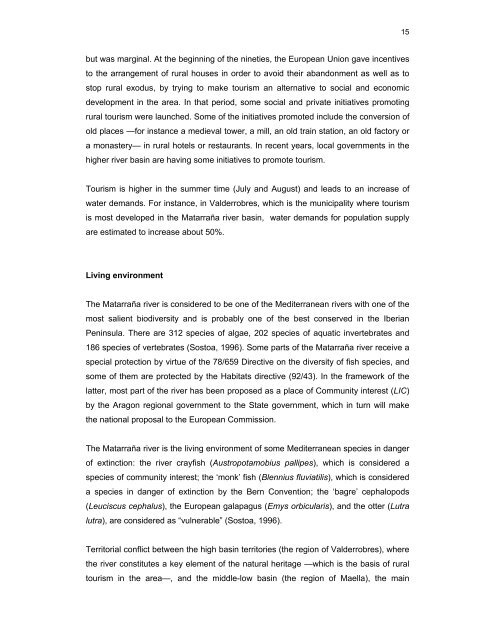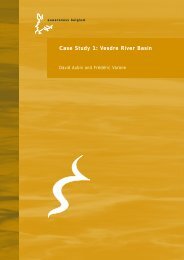Case Study 1: Matarraña River Basin - Euwareness
Case Study 1: Matarraña River Basin - Euwareness
Case Study 1: Matarraña River Basin - Euwareness
You also want an ePaper? Increase the reach of your titles
YUMPU automatically turns print PDFs into web optimized ePapers that Google loves.
ut was marginal. At the beginning of the nineties, the European Union gave incentives<br />
to the arrangement of rural houses in order to avoid their abandonment as well as to<br />
stop rural exodus, by trying to make tourism an alternative to social and economic<br />
development in the area. In that period, some social and private initiatives promoting<br />
rural tourism were launched. Some of the initiatives promoted include the conversion of<br />
old places —for instance a medieval tower, a mill, an old train station, an old factory or<br />
a monastery— in rural hotels or restaurants. In recent years, local governments in the<br />
higher river basin are having some initiatives to promote tourism.<br />
Tourism is higher in the summer time (July and August) and leads to an increase of<br />
water demands. For instance, in Valderrobres, which is the municipality where tourism<br />
is most developed in the <strong>Matarraña</strong> river basin, water demands for population supply<br />
are estimated to increase about 50%.<br />
Living environment<br />
The <strong>Matarraña</strong> river is considered to be one of the Mediterranean rivers with one of the<br />
most salient biodiversity and is probably one of the best conserved in the Iberian<br />
Peninsula. There are 312 species of algae, 202 species of aquatic invertebrates and<br />
186 species of vertebrates (Sostoa, 1996). Some parts of the <strong>Matarraña</strong> river receive a<br />
special protection by virtue of the 78/659 Directive on the diversity of fish species, and<br />
some of them are protected by the Habitats directive (92/43). In the framework of the<br />
latter, most part of the river has been proposed as a place of Community interest (LIC)<br />
by the Aragon regional government to the State government, which in turn will make<br />
the national proposal to the European Commission.<br />
The <strong>Matarraña</strong> river is the living environment of some Mediterranean species in danger<br />
of extinction: the river crayfish (Austropotamobius pallipes), which is considered a<br />
species of community interest; the ‘monk’ fish (Blennius fluviatilis), which is considered<br />
a species in danger of extinction by the Bern Convention; the ‘bagre’ cephalopods<br />
(Leuciscus cephalus), the European galapagus (Emys orbicularis), and the otter (Lutra<br />
lutra), are considered as “vulnerable” (Sostoa, 1996).<br />
Territorial conflict between the high basin territories (the region of Valderrobres), where<br />
the river constitutes a key element of the natural heritage —which is the basis of rural<br />
tourism in the area—, and the middle-low basin (the region of Maella), the main<br />
15



